- Indonesia’s Sulawesi is home to the maleo, a bird with highly unusual reproductive behaviors, and threatened for decades with extinction.
- Loss of nesting sites and harvesting of the maleo’s huge, nutritious eggs has drastically reduced their numbers, which at last count came to just 4,000-7,000 breeding pairs.
- A unique partnership between conservationists, birders, local villagers and farmers — done for remarkably little money — has begun to reverse the maleo’s fortunes, with more than 10,000 chicks hatched and released over the last 15 years.
Conservation success stories are rare. Too often we read of the losing battles: local extinctions and irreversible biodiversity losses, often at the expense of shortsighted exploitation-for-profit schemes. Refreshingly, the plight of the maleo is different. This story is one of conservation success.
Maleos are, by all accounts, weird birds. They are chicken-like creatures with duotone plumage; a minimalist contrast of coal-black above and soft, peach-pink below. The bare, multi-colored skin of their heads — somewhat reminiscent of a vulture — is capped by a strange, bulbous protrusion called a casque. This adornment has affectionately been described as a football helmet or a walnut, or less affectionately as an engorged tick.
Maleos are megapodes — mound-builders — members of a 26-species family of ground-dwelling birds peppered across the islands of Australasia, many endemic to their respective landmasses.
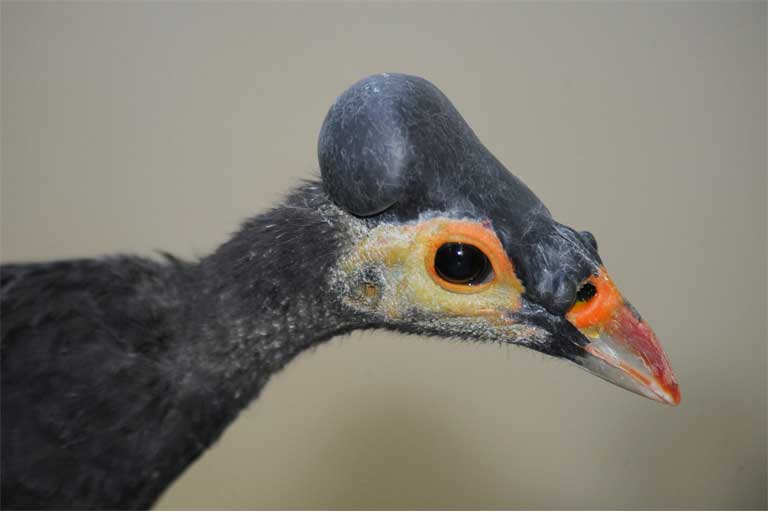
The megapode we are concerned with here is Macrocephalon maleo, found only on Sulawesi; the fourth-largest island in Indonesia and the eleventh-largest island in the world. Sulawesi, just east of Borneo, is a collection of peninsulas: four spokes of sand and inland forest attached to a hub of tall, imposing mountains.
Indonesia has the dubious honor of hosting more species threatened with extinction than any other country on Earth, and the maleo is among them. It went from Vulnerable on the IUCN Red List in 2000 to Endangered in 2002, and has stayed there since. IUCN’s most recent estimates put the total existing population at 4,000-7,000 breeding pairs (12,000-21,000 individuals).
Recently however, their story began to take a considerably more hopeful turn — and a lot of that shift has to do with this bird’s bizarre breeding behaviors and people’s fascination with it.
Digging the maleo’s reproductive cycle
Maleos are swift, plump birds built on stout legs that help them weave through the forest understory. But running isn’t the only thing for which maleos use their powerful legs.
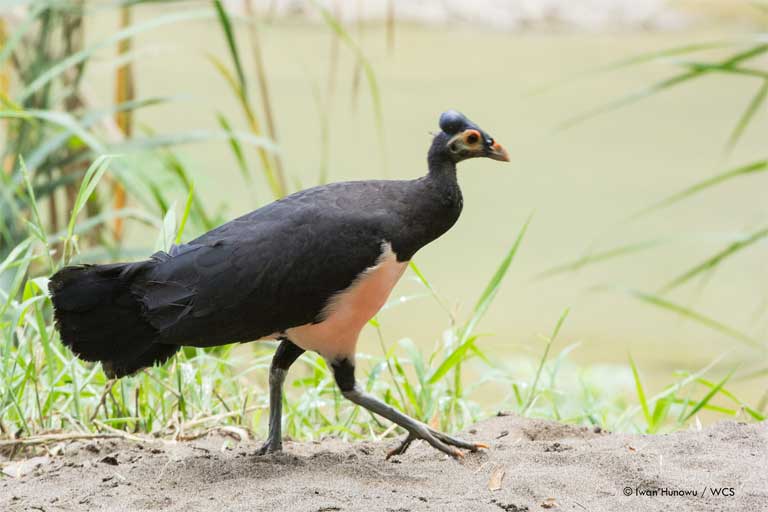
Unlike many other birds, megapodes such as the maleo don’t incubate their nests using body heat; rather they let nature do the work. As their name suggests, most mound-builders scrape together enormous piles on the forest floor; a layer of decomposing vegetation on bottom, with a layer of soil or sand on top, and eggs sandwiched in between. The chemical process of vegetative decay below releases heat which is then trapped by the blanketing layer of earth, resulting in incubation.
Whereas some megapode species dutifully attend their mounds — adding or removing content to maintain the proper temperature within — maleos evolved using a different strategy.
Maleos on Sulawesi tap the natural resources of the island, relying on heat from thermal vents or sun-warmed sand to incubate their eggs. And instead of building up like other megapodes, maleos dig down. A maleo pair works together to excavate a hole at a communal nesting area, sometimes surrounded by other maleos doing the same thing. This is a scene that can quickly devolve into bedlam as more maleo pairs join the fray; a fury of kicking sand and clucking birds. A visit to a maleo nest site can be like attending a dozen weddings at once, with everyone throwing rice at each other, everyone shouting, and prowling bachelors looking for trouble.
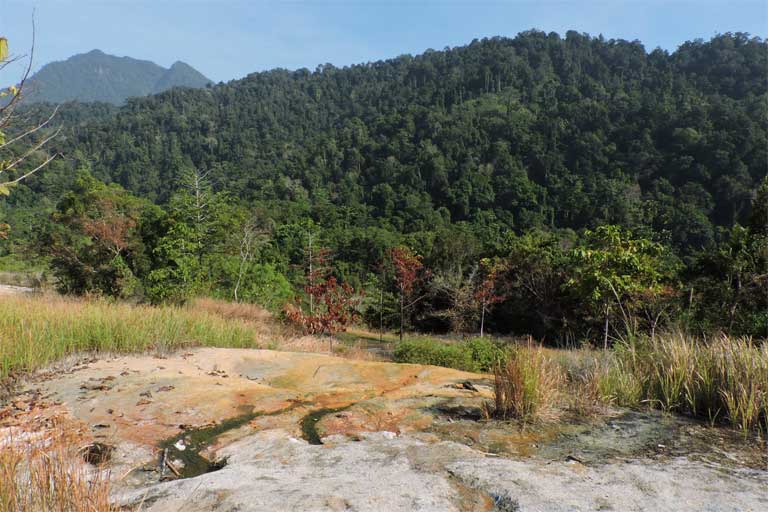
Despite the chaos, maleo digging is not haphazard and egg placement is not random. As the birds excavate furiously — one of the pair digs while the other watches for predators or interloping maleos — they also gauge the substrate temperature. The birds regularly sample sand or earth with their mouths as they dig, thus “tasting” the temperature as they go. When they find a pocket of 33ᵒC (91ᵒF) soil, give or take a degree, they stop. This is the maleo sweet spot. The female then lays a single, massive egg, which she carefully places upright in the hole, then covers.
This egg, five times larger than a chicken egg and containing twice as much yolk, is the largest laid by any megapode. When the young bird hatches it’s going to need all that protein, because once buried the adult pair leaves the egg and hopes for the best. Parental duties complete — for that chick. Over a two or three month period the pair does return to the same nest site and repeats the reproductive process up to a dozen times: digging, laying, covering, walking away.
Taking a running start at life
When a maleo chick hatches after 60-90 days of incubation, it hits the ground running. Literally.
The first thing the chick must do is burrow to the surface, sometimes through a meter of soil or sand, a harrowing task that can take up to two days. Next, the maleo instinctively makes a break for the forest; running and even flying.
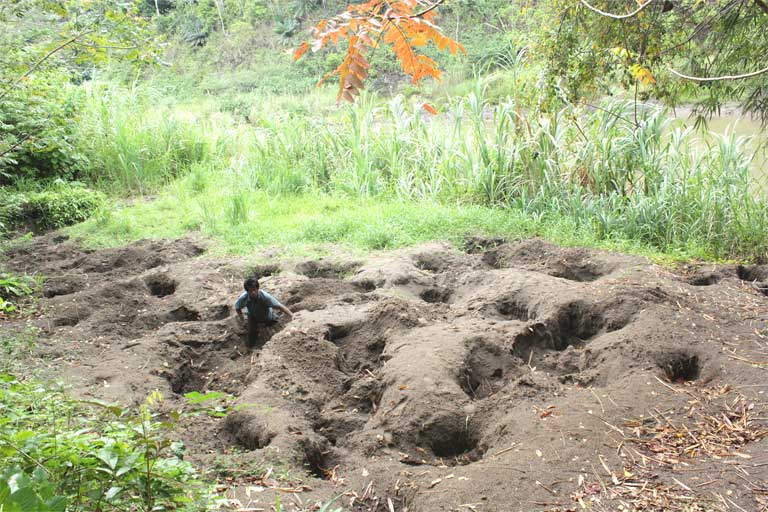
“Watching a maleo chick come out of the ground and fly away is a remarkable sight,” says Iwan Hunowu, a maleo conservationist for the Wildlife Conservation Society’s Indonesia Program (WCS Indonesia). In fact, this astonishing behavior at such a young age makes maleos among the most physically-mature vertebrate newborns on the planet.
One of Mr. Hunowu’s colleagues, Matt Leggett, notes that a freshly-hatched maleo is surprisingly tenacious: “The first chick I saw hatch took to the air but landed in a river, where it swam 10 meters [33 feet] through sizable rapids, climbed up the opposite bank, then flew off again.” Not bad for a two-day-old.
The maleo’s unique life cycle — particularly its utter reliance on conspicuous and exposed communal nest sites — has made the species vulnerable to human threats. Sulawesi villagers have a long history of harvesting, then selling the protein-laden eggs. In addition to human nest site poachers, there is the problem of vanishing habitat; the distance between coastal nest sites and the forests where the birds live continues to widen.

Farmers, with few economic alternatives, clear away the Sulawesi forests for agriculture, while cash-strapped local governments open them for logging. At some point, maleos regard the expanding gap between nest and forest as unacceptable, perhaps understanding that a two-day-old bird cannot cross the gauntlet of that ever-widening barrier, and another historical nest site is abandoned.
Saving Sulawesi’s maleos
The first efforts to protect maleos began in the 1980s and took on added urgency in the early 2000s, when a survey reported abandonment of more than half the known nest sites in northern Sulawesi. Across the island as a whole, 48 of the 142 known nesting grounds had been abandoned by 2002, another 51 were severely threatened, and 32 were threatened.
In 2001, WCS Indonesia began protecting nest sites at Bogani Nani Wartabone National Park on the northern Minahasa Peninsula, and the Alliance for Tompotika Conservation helped initiate a ban on egg collecting in 2004 on the East Peninsula. In both locations, maleo protection programs developed in partnership with local interest groups and were underpinned by the idea that villagers living near nest sites have the most to gain by maleo conservation.
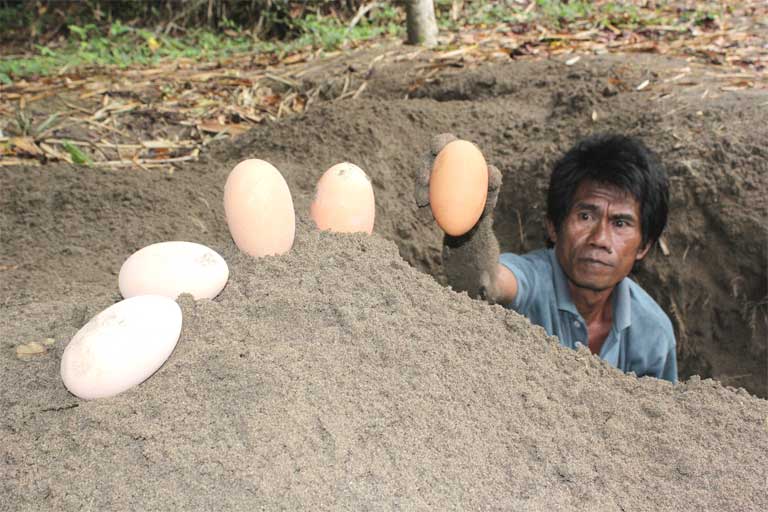
Former poachers and other villagers were hired to monitor maleo nest sites, thus swapping an illegal lifestyle for a sustainable one. In addition to deterring poaching, these monitors also assess population size by documenting the number of adult maleos that visit nest sites, and they transplant some eggs to a semi-natural, fenced-off section of ground where they are protected from predators.
While the egg guardians may have initially signed on due to the financial incentive — one can earn a better income protecting maleo eggs than stealing them — a number of villagers now rally around the maleo as a source of local pride.
However, conservation groups recognize that the guardian model, largely funded via a perpetual cycle of grant applications, awards, and reports, is not necessarily sustainable: pride cannot pay the bills. Conservationists worry that one day a major grant will fail to materialize and maleo protectors will go unpaid, perhaps causing desperate guardians to revert to poaching in order to provide for their families.
The bird watching bonanza
Luckily, maleos can offer something more to human communities. Sulawesi is thought to support a greater number of endemic birds than anywhere else in the world, with 41 species found nowhere else, and a staggering 12 endemic genera. This fact is especially significant for the throngs of affluent birdwatchers staring at 41 empty check boxes on their life lists.
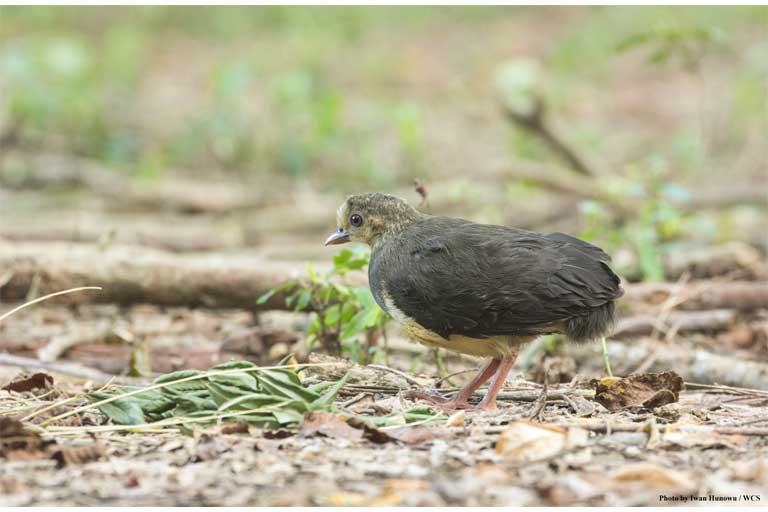
Jon Riley, the Program Manager for WCS Indonesia at the inception of the maleo conservation program, notes that the maleo’s gaudy flair for the bizarre gives it broad appeal beyond birdwatchers: these are not the macaques (loved by tourists but despised by villagers for the crop damage they cause), or drab songbirds that vanish into the foliage and about which locals cannot understand why all the fuss is being made. Maleos, with their conspicuous pit-digging antics and track star two-day-old chicks, are celebrities for all.
Maleo-focused conservation groups have wisely tapped into this universal interest, and many of the protected nest sites now offer eco-tours to generate additional and more reliable income for local villages.
Visiting a maleo nest site, says Mr. Riley, is fascinating: “it’s a tactile species: you can see them, hear their unusual vocalizations, see their burrows, handle their eggs — and once an audience is hooked, guides can pivot the dialogue from ecology to conservation. [Guides] explain that maleos are endemic to Sulawesi and in need of our help.”
Maleos on the beach, and in the Big Apple
In 2008, and with support from WCS Indonesia, an NGO called Pelestari Alam Liar dan Satwa (PALS) took maleo conservation to a new level: they bought the beach. Specifically, a 22-hectare (54 acre) patch of sand and trees centered on a maleo nest site. In doing so they created the Binerean Nature Reserve. The former landowners, a collection of coconut farmers, were then hired to manage the park with PALS oversight. The farmers now harvest their coconuts in a “maleo-friendly” fashion.

This enterprise ideally balances the needs of people and maleos. It maintains pre-park levels of income for local landowners, provides funding for reserve management and protection, while at the same time guaranteeing disturbance-free nesting for maleos. It’s the difficult win-win scenario conservationists are continually seeking.
This success story led to additional PALS land purchases. Today nearly 150 hectares (370 acres) of maleo habitat is under sustainable maleo management. That includes a forest corridor between Binerean Nature Reserve and Sulawesi’s closest national park.
Still, maleo reproductive conditions aren’t perfect. Even with poacher and nest predator deterrents, maleo hatching success rates in the wild only hover around 50 percent. Conservationists, eager to increase those odds to help the species rebound, found help in an urban setting halfway around the globe: WCS’s Bronx Zoo in New York City. This zoo is now the only place on earth, outside of Sulawesi, where birders and other visitors can see maleos.

The zoo’s ornithological staff has, over time, painstakingly replicated natural breeding conditions there. Each of the two zoo-kept maleo pairs is furnished with a “pit room” boasting a meter-deep sandbox with pockets warmed to 33ᵒC (91ᵒF). Such fussy conditions are vital to reproduction: if the maleos can’t find the perfect temperature, they will dig but won’t lay eggs. Staff keep close tabs on breeding behavior and swoop in to remove an egg for artificial incubation the moment it is laid. But how do keepers know when laying is imminent?
“The critical moment is the ‘peanut test,’” laughed Alana O’Sullivan, a Senior Wild Animal Keeper in a recent conversation in the off-exhibit maleo breeding wing of the Bronx Zoo. Apparently, maleos will do anything within their power to acquire – then rapidly consume – a peanut. The moment this treat is offered and refused, the staff know a female is singularly focused on reproduction: she’ll lay sometime within the next 24 hours.
After six years of brow-furrowing trial and error, in which zoo staff tested the impact of varying factors such as substrate type, temperature, and relative humidity on egg development, the Bronx Zoo is now able to hatch maleo eggs with an impressive 91 percent success rate — almost twice as high as in the wild.
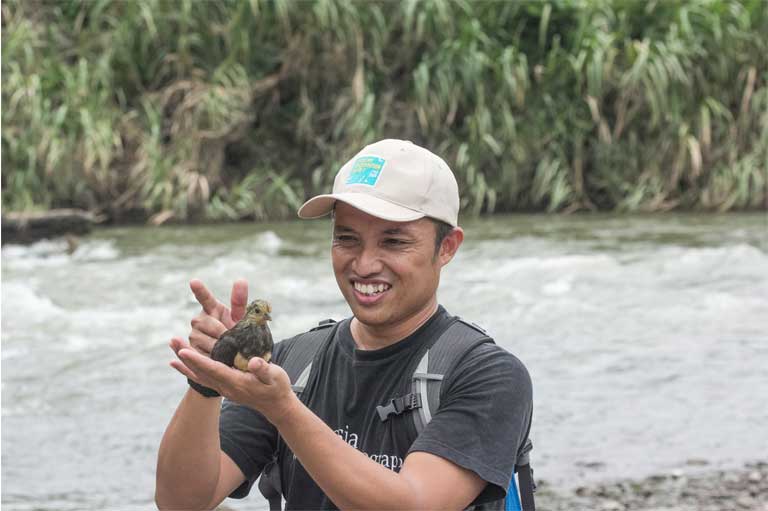
Eggs are carefully scooped out of the warm sandpits and positioned in a beaker of sterilized plastic beads with a strict temperature of 32.5ᵒC (90.5ᵒF), and a relative humidity of 89-90%. This maleo cookbook has been shared with incubators on Sulawesi nearly 10,000 miles away, thus improving hatch success in situ, and resulting in more maleo chicks fluttering resolutely toward the tree line.
Hope for Sulawesi’s maleo megapode
While there have been clear, quantifiable conservation successes both in the wild and in captivity, whether those efforts translate to improving maleo numbers is less obvious. True, more than 10,000 maleo chicks have been successfully hatched and released from WCS-managed sites alone over the past 15 years, but what happens to those birds post-release remains largely unknown. How many actually survive to breed themselves? No one can say.
One positive indication comes from “translocation” programs, where eggs from an active nest site are transferred to the sands of an abandoned nest site; some such chicks have grown to adulthood and returned to renew the breeding cycle at those once-silent beaches.
Another indication comes from the village of Libuun, where after a decade of egg protection and community involvement overseen by the Alliance for Tompotika Conservation, the number of adult maleos recorded at the nest site there has tripled.
However, for the momentum of maleo conservation to continue on a positive trajectory, the focus should remain on protecting and restoring nest sites and forest habitat, rather than encouraging more hatcheries and more chicks. Without maleo habitat for these chicks to return to the hatcheries themselves are useless.
As stunning as the maleo conservation success story is, the price for the species rescue is even more astounding. The job is being done on the cheap, and is comparatively inexpensive. Each fledged chick represents a mere $4 investment, with the combined WCS-managed sites on the Minahasa Peninsula operating on only about $40,000 annually. However, maleo conservationists lament that even that modest sum is raised with difficulty and they could really use more: $100,000 annually would be optimal to ensure site protection, build community outreach, and conduct research.
It’s easy to lose hope under the barrage of negative wildlife news; the never-ending Twitter feeds regarding severed rhino horns or suitcases bursting with pangolin scales. But thanks to a motley team of conservationists, former egg poachers, coconut farmers, international birders, and Bronx zookeepers, there’s hope for the maleo yet. And that, my friends, is a conservation success story worth savoring and celebrating.
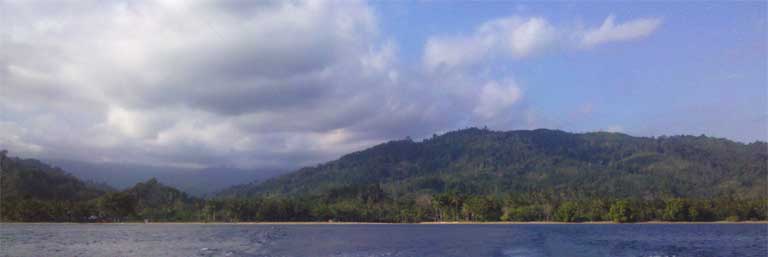
Citations:
Argeloo, M., and R. W. R. J. Dekker. (1996). Exploitation of megapode eggs in Indonesia: the role of traditional methods in the conservation of megapodes. Oryx 30:59-64.
Clements, T. (2009). TRANSLINKS Case Study: Conservation of Sulawesi’s Endangered Mascot–the Maleo – through Conservation Incentive Agreements. Wildlife Conservation Society, New York.
Dekker, R. W. R. J. (1990). The distribution and status of nesting grounds of the maleo Macrocephalon maleo in Sulawesi, Indonesia. Biological Conservation 51:139-150.
Gorog, A. J., B. Pamungkas, and R. J. Lee. (2005). Nesting ground abandonment by the maleo (Macrocephalon maleo) in North Sulawesi: Identifying conservation priorities for Indonesia’s endemic megapode. Biological Conservation 126:548-555.
Hance, J. (2010). Saving the maleo, a geothermal nesting bird in Sulawesi. December 6, 2010. Accessed at www. mongabay.com.
MacKinnon, J. (1981). Methods for the conservation of maleo birds, Macrocephalon maleo on the island of Sulawesi, Indonesia. Biological Conservation 20:183-193.
Review questions for educators
These questions can help provide a framework for exploring topics presented in this story.
- What is the maleo?
- Where does the maleo live?
- Why is the maleo unusual?
- Why is the maleo endangered?
- How are maleos supporting local livelihoods?
- How are conservationists working to protect the maleo?
